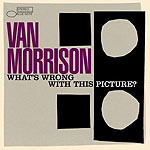
Morrison still on top
|
This review first appeared in the January 29, 2004 issue of the North County Times.
Trying to pin singer Van Morrison down to a single style or even specific mixture has been driving music writers crazy for four decades now. He's of the rock 'n' roll generation, but not primarily a rock musician. He moves easily between blues, Irish folk, jazz, country and whatever else he's ever listened to – but isn't really of any of those styles, either.
In the end, it's easier, as well as more accurate, to simply admit that Morrison is utterly unique, in his own place in the musical spectrum.
Once one is at peace with accepting Morrison's musical singularity, his new contract with the jazz label Blue Note makes sense. If not a jazzster, both his songs and his singing have always had a jazzlike honesty at their center – an essence that has led jazz musicians of all stripes to play and record his songs for the past forty years.
All of that we already knew about Van Morrison. What his first album from Blue Note, "What's Wrong With This Picture," tell us new about him is the fact that his songwriting continues to deepen and mature. Few composers of the popular song have ever had their productivity last so many decades. Thirty-seven years after he wrote the classic "Brown-Eyed Girl," this new release contains several songs destined for similar immortality. "Evening in June" and "Once in a Blue Moon" are as gorgeous love songs as he's yet written, the title song is a powerhouse anthem, and "Goldfish Bowl" is the best takedown of the culture of celebrity you'll ever hear.
And his lyrics still display that delightful (and obviously delighted) wordplay that ultimately makes Morrison's music a product of his native Ireland. That love of words still illuminates and defines his songs, gives them so much more impact than any angry protest song ever well. Even when angry, Morrison is still able to channel that into absolute poetry. And for lyrical poetry, only Morrison can use a word like "existential" in a song and make it flow (from "Meaning of Loneliness").
He also displays a wonderfully nuanced touch as an interpretor of others' songs. His covers of the old jazz standard "St. James Infirmary" and Lightnin' Hopkins' "Stop Drinking" are both able to be fully modern while also hearkening back to the earliest days of jazz and blues.
"What's Wrong With This Picture" shows that Morrison is in that rare company of artists like Duke Ellington or Edith Piaf who simply defy description and criticism. He can't be pegged, only appreciated.
